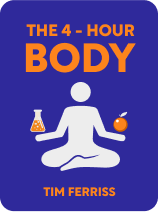

This article is an excerpt from the Shortform book guide to "The 4-Hour Body" by Timothy Ferriss. Shortform has the world's best summaries and analyses of books you should be reading.
Like this article? Sign up for a free trial here .
What is The 4-Hour Body diet plan? How can you start 4-Hour Diet and what results can you expect?
The 4-Hour Body diet helped author Tim Ferriss lose 20 pounds of fat in a month. The Four-Hour Body Diet is also known as the Slow-Carb diet.
Keep reading for an overview of the rules for the The 4-Hour Body diet plan.
The 4-Hour Body Diet: The Slow-Carb Diet
The first recomp factor is diet. The 4-Hour Body diet plan was developed by the author through self-experimentation and works for almost everyone who follows it properly. On The 4-Hour Body diet, the author lost 20 pounds of fat within a month.
To follow the Slow-Carb Diet:
- Stop eating white-colored carbohydrates, or any carbohydrates that come in white-colored varieties (like rice).
- Repeat the same 3-4 meals regularly on The 4-Hour Body diet4. This allows you to avoid foods that will make you gain fat and ensure you get enough protein (at least 20 grams per meal). Each meal should contain one item from each of the following categories:
- Protein: eggs (especially whites), beef, fish, pork, chicken thigh or breast
- Legumes: lentils, soybeans, pinto beans, red beans, black beans
- Vegetables: any vegetables you like
- Eat two to three times what you used to. Slow-carb foods have a low calorie-to-volume ratio.
- Eat breakfast within an hour of waking up and eat four meals a day, four hours apart.
- Drink lots of water and as many low- or no-calorie drinks as you like. Don’t drink juice, milk, or soda. Optionally drink fewer than 16 ounces of diet soda or two glasses of dry red wine a day.
- Avoid fruit, except for tomatoes and avocados in moderation. Fruit contains the sugar fructose, which will make you fat.
- Don’t eat dairy, except for cottage cheese on The Four-Hour Body Diet. Dairy produces a large insulin release, which will make your body store fat.
- Follow The Four-Hour Body Diet only six days per week. On the seventh day, eat and drink whatever you want, all the no-nos above included. This “cheat day” won’t only keep you happy; it’ll maintain your metabolism, which slows when you restrict calories. Your metabolism is what makes you lose weight, so it’s important to keep it going strong.
Losing the Last Few Pounds
Diet is the most important factor when it comes to losing your last few pounds. Move from the Slow-Carb Diet to the following 4-Hour Diet. Eat one of the following five meals every three hours. You have to eat your first meal within an hour of waking and your last meal within the hour before sleeping. You can’t skip any.
- Whey protein and nut butter OR nuts
- Cooked, non-fatty, white fish and nut butter OR nuts
- Cooked chicken or turkey and nut butter OR nuts
- Cooked, fattier protein such as ground beef or dark poultry and macadamia or olive oil
- Eggs
At each meal, you can also eat as much as you want of broccoli, collards, asparagus, spinach, kale, and Brussels sprouts. You can have a cheat meal every week or so.
If you weigh 160 pounds or less, eat the following quantities for this phase of the 4-Hour Diet:
- 30 grams of whey protein
- One tablespoon of nut butter or a quarter cup of nuts
- 4 ounces of meat
- Half a tablespoon of oil
- 3 eggs
If you’re heavier than 160 pounds, adjust the portions:
- To get the amount of whey protein, multiply your weight in pounds by 0.25.
- For example, if you’re 200 pounds, you should eat 50 grams.
- To get the number of tablespoons of nut butter, divide your weight in pounds in half.
- If you’re 200 pounds, you should eat 2 tablespoons.
- To get the number of cups of nuts, divide your weight in pounds by 400.
- If you’re 200 pounds, you should eat half a cup.
- To get the ounces of protein, for each additional 10 pounds of lean body mass you have, add an ounce.
- If you’re 200 pounds, eat 8 ounces.
- To get the amount of oil, divide your weight in pounds by 400.
- If you’re 200 pounds, you should eat half a tablespoon.
- To get the number of eggs, divide your weight in pounds by 40.
- If you’re 200 pounds, you should eat five.
Supplements
You don’t have to take supplements with The 4-Hour Body diet—it works fine on its own—but if you’d like to, the author has four recommendations:
- Cissus quadrangularis. This medicinal plant is usually used for joint repair, but when the author was taking it after elbow surgery, he noticed that it also stopped him from gaining weight. He took 2.4 grams half an hour before eating, three times a day, and didn’t gain weight even though at that time in his life, he was eating a lot of rice and sugar.
- Alpha-lipoic acid. See Chapter 7 for more detail on its uses.
- L-glutamine. This amino acid helps repair tissue, notably the intestines, which need to be in good working order to process all the food you have to eat as part of the protocol. For the first five days of the protocol, consume 10 grams every two hours until you reach 80 grams. On subsequent days, optionally consume 10-30 grams after each workout.
- Creatine monohydrate. This compound increases protein synthesis, as well as the force of muscle. Have 5-20 grams daily, 3.5 grams when you wake up and before bed daily.
Strategies for Sticking to a Diet
No matter which diet you use, you have to stick with it to see recomp changes. However, humans are inherently bad at making permanent lifestyle changes. Fortunately, there are five strategies to help you stay on track:
Strategy #1: Prioritize. The first strategy is to pick and choose between the four strategies below. You only need to change the minimum amount that will create results. Choose two of the four strategies marked with an asterisk (*) to get started.
Strategy #2: Be aware of your behavior as it happens. It’s less useful to become aware of actions after they’ve occurred because there’s no way to change them. For example, reflect on what you’re eating before you eat it. Specifically:
- *Photograph your food. Take photos of all your meals and snacks for 3-5 days and include your hand in the photos for scale. Put the photos somewhere public, such as online, so you know that other people know what you’re eating. This will force you to reflect on your choices.
- *Use before and after photos. Take a photo of yourself in your swimsuit or underwear and place the photo in a prominent location where you’ll come across it often, such as on your fridge. Every time you see it, you’ll be reminded of what you’re trying to change and be less inclined to self-sabotage by making bad dietary choices.
Strategy #3: *Motivate yourself by taking measurements. Measure and track your body fat percentage, total inches, and any additional measurements you’re interested in. Once you hit five entries, you’re likely to become hooked.
- For example, people can track their runs on the Nike+ site. People who track more than five runs are more likely to keep on tracking.
Strategy #4: Harness the power of competition. Adding an element of game or competition to your diet motivates you to change your behavior so you can “win” the game. Interestingly, humans are more motivated by failure than success—scientists have discovered that people are more distraught about losing $50 than winning $50—so use negative stakes in particular, such as humiliation, for motivation. Specifically:
- *Start a competition with someone. Compete with someone to see who can most decrease their TI, body fat, or as a last resort, weight.
- Increase the stakes of a competition by betting on the outcome.
- For example, Ramit bet his entire contact list that in 90 days, he could gain 15 pounds of muscle. He trash-talked to make it even more humiliating if he lost. He quickly met his goal.
- Make the competition public. For example, post about it on social media. You’ll work harder when you think someone’s watching you.
- Employ social comparison theory, which states that in a group, you’ll be better than some people and worse than others. Compare yourself to the people below you to feel good about yourself, and compete with those above you—if they can do it, you can too.
Strategy #5: Don’t try to change multiple lifestyle factors all at the same time because you’ll get overwhelmed.
- For example, if you don’t cook, eat frozen or canned food so you don’t have to both diet and learn to cook at the same time.

———End of Preview———
Like what you just read? Read the rest of the world's best book summary and analysis of Timothy Ferriss's "The 4-Hour Body" at Shortform .
Here's what you'll find in our full The 4-Hour Body summary :
- How to do the least amount you need to do for the results you want
- Why you need a cheat day in your diet
- How to improve everything about your body, including sleep, sex, and longevity






